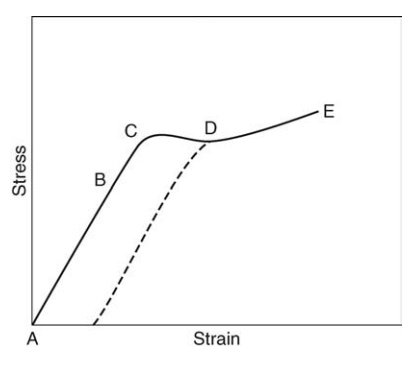Fundamental Aspects of Crushing and Grinding
| Home | | Pharmaceutical Technology |Chapter: Pharmaceutical Engineering: Size, Reduction and Classification
A basic study of crushing and grinding considers the physical properties of the material, the crushing mechanism itself, and its relation to the mechanism of failure.
FUNDAMENTAL ASPECTS OF CRUSHING
AND GRINDING
A basic study of
crushing and grinding considers the physical properties of the material, the
crushing mechanism itself, and its relation to the mechanism of failure. When a
stress, which may be compressive, tensile, or shear, is applied to a solid, the
latter deforms. Initially, the deformation or strain is the distortion of the
crystal lattice by relative displacement of its components without change of
structure. Complete recovery follows the removal of the stress, and behavior is
elastic. Figure 12.1 considers the deformation of a solid under a tensile
stress, and elastic behavior is shown over section AB. Below the elastic limit,
B, stress is proportional to strain and is related to it by various moduli.
Beyond the yield point, C, permanent or plastic deformation occurs and, as
shown by release of stress at point D, all strain is not recoverable. Sliding
along natural cleavage planes is occurring in this region. Plastic deformation
is terminated by failure or fracture, which is normally a quite gradual and
reproducible process preceded by thinning of the material. The stress at point
E is a measure of the strength of the material. The area under the curve at any
point represents the strain energy per unit volume absorbed by the specimen up
to that strain. The limiting strain energy per unit volume is the energy
absorbed up to the point of failure.
An
extensive period of plastic deformation is shown in Figure 12.1, and the
material would be classified as ductile. For the brittle materials normally

FIGURE 12.1 The tensile deformation of a
ductile material
Fracture is explained here in terms of cracks and flaws
naturally present in the material. It occurs suddenly and with shattering. The
energy employed in stressing the particle to the point of failure reappears
mainly as heat on release of strain in a manner analogous to the sudden release
of a stressed spring.
The
theoretical strength of crystalline materials can be calculated from
interatomic attractive and repulsive forces. The strength of real materials is,
however, found to be many times smaller than the theoretical value. The
dis-crepancy is explained in terms of flaws of various kinds, such as minute
fissures or irregularities of lattice structure known as dislocations. These
have the capacity to concentrate the stress in the vicinity of the flaw.
Failure may then occur at a much lower overall stress than is predicted from the
theoretical considerations. Failure occurs with the development of a crack tip,
which propagates rapidly through the material, penetrating other flaws, which
may, in turn, produce secondary cracks. The strength of the material therefore
depends on the random distribution of flaws and is a statistical quantity
varying within fairly wide limits. This concept explains why a material becomes
progressively more difficult to grind. Since the probability of containing an
effective flaw decreases as the particle size decreases, the strength will
increase until, with the achievement of faultless domains, the strength of the
material will equal the theoretical strength. This position is not realized in
practice because of com-plicating factors such as aggregation.
The
strength of most materials is greater in compression than in tension. It is
therefore unfortunate that technical difficulties prevent the direct use of
ten-sile stresses. The compressive stresses commonly used in comminution
equip-ment do not cause failure directly but generate, by distortion,
sufficient tensile or shear stress to form a crack tip in a region away from
the point of primary stress application. This is an inefficient but unavoidable
mechanism. Impact and attrition are the other basic modes of stress
application. The distinction between impact and compression is referred to
below. Attrition, which is commonly employed, is difficult to classify but is
probably, primarily, a shear mechanism.
In
any machine, one mode of stress application usually predominates. It must be
correctly chosen with respect to the mechanical properties of the material.
Compression, for example, is useless for comminution of fibrous or waxy solids.
Attrition is generally necessary for all fine grinding.
The
deformation and subsequent failure of a brittle material is a function not only
of stress but also of the rate at which the stress is applied. Different
results may be obtained from slow compressive breaking and impact breaking at
the same energy. Particle shape, size, and size distribution may be affected.
In impact breaking, the rate of stress application is so high that the limiting
strain energy may be exceeded several times by the suddenness of the operation.
This is because fracture is time dependent, a lag occurring between the
application of maximum stress and failure.
Stress
application is further complicated by “free-crushing” and “packed-crushing”
mechanisms. In free crushing, the stress is applied to an uncon-strained
particle and released when failure occurs. In packed crushing, the application
of stress continues on the crushed bed of particles. Although further size
reduction occurs, the process is less efficient because of vitiation of energy
by the effects of interparticulate friction and stress transmission via
particles that do not themselves fracture. This is easily demonstrated when a
crystalline material is ground in a pestle and mortar. The fine powder
initially produced protects coarser particles. If the material is sieved and
oversize particles are returned, the operation may be completed with far less
effort.
Free
crushing is most nearly approached in the roller mill, which explains the high
efficiency of the machine, and, to a lesser extent, in other continuous
processes in which individual particles are presented to the grinding media.
Packed crushing occurs in ball mills.
